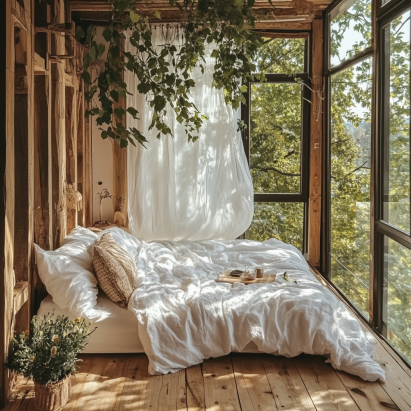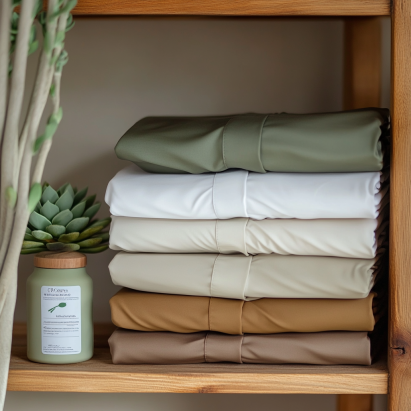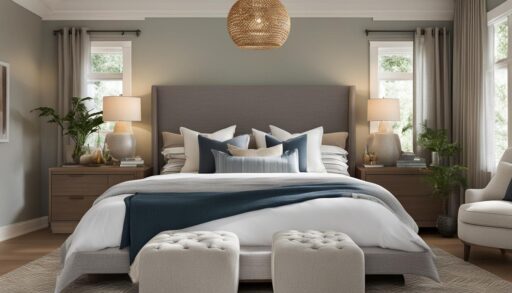Eco-Friendly Sleeping
Looking to create a healthier sleep space and reduce your carbon footprint? Eco-Friendly Sleeping is a smart, impactful choice that supports the planet while giving you a better night’s rest. From breathable fabrics to low-impact manufacturing, small choices lead to big benefits for your well-being and the earth. Learn more about eco-friendly and sustainable sleep strategies.

Key Takeaways
- Eco-Friendly Sleeping promotes a cleaner, healthier sleeping environment by eliminating exposure to harmful chemicals.
- Sustainable materials like organic cotton and bamboo offer better breathability and temperature regulation.
- Choosing eco-friendly products supports ethical manufacturing and reduces your carbon footprint.
- Proper maintenance keeps bedding comfortable and extends its lifespan, reducing waste over time.
- Eco-conscious sleeping benefits everyone—from allergy sufferers to growing kids.
- Simple decor choices can make your whole room more eco-aligned and tranquil.
What is Eco-Friendly Sleeping?
Eco-Friendly Sleeping refers to bed linens and sleep environments crafted from sustainable, non-toxic materials designed to minimize environmental impact and maximize your personal comfort. It’s more than a product category—it’s a shift in lifestyle that prioritizes both environmental stewardship and personal well-being. For more on the benefits, explore our eco-friendly sustainable bedding guide.
Imagine stepping into a serene bedroom filled with soft, breathable organic cotton sheets, a bamboo mattress topper, and curtains made from recycled fibers. The scent of lavender essential oil lingers in the air, and the lighting is warm and calming thanks to LED bulbs and natural daylight. This is the vision of eco-friendly sleeping—a haven that supports restful sleep and sustainability in equal measure.
Brands like Boll & Branch and Avocado Green are leading the way in this space, producing luxurious bedding and mattresses with certified organic materials, ethical labor practices, and low-emission production. These companies serve as examples of how Eco-Friendly Sleeping can be practical, stylish, and impactful.
Whether you’re upgrading your entire bed or starting small with a new set of sustainable sheets, every choice contributes to a cleaner, greener lifestyle. It’s about making daily decisions that align with values of health and harmony—with nature and within your home. For innovative ideas, check out our feature on the cardboard bed frame.

Benefits of Eco-Friendly Sleeping
Switching to eco-friendly bedding isn’t just a trend—it’s a commitment to your health and the environment. Organic and natural fibers reduce skin irritation and respiratory issues. In fact, a study published by the Environmental Working Group found that people are exposed to an average of 12 industrial chemicals from conventional bedding during sleep each night. These substances have been linked to endocrine disruption, allergic reactions, and respiratory problems.
Additionally, synthetic bedding often contains volatile organic compounds (VOCs), which can off-gas into your bedroom air. According to the U.S. Environmental Protection Agency (EPA), prolonged exposure to VOCs can contribute to symptoms like headaches, nausea, and fatigue. Choosing eco-friendly materials such as GOTS-certified organic cotton eliminates these hazards and supports a cleaner sleep environment.
According to the Sleep Foundation, maintaining toxin-free bedding is essential for healthy sleep hygiene. By minimizing chemical exposure, your body can relax more deeply, leading to more restorative rest and improved overall wellness. Discover how sustainable bedclothes support a greener future.
In short, choosing Eco-Friendly Sleeping options is a powerful way to protect your health and sleep better—night after night.

Top Eco-Friendly Bedding Materials
When it comes to Eco-Friendly Sleeping, the materials you choose make all the difference. For deeper insight, explore our guide on eco-friendly bedding and sustainable sleep solutions. Here’s a side-by-side comparison of the most popular eco-friendly bedding materials:
- Organic Cotton
- Feel: Soft, breathable, slightly crisp
- Longevity: High durability with proper care
- Sustainability: Very sustainable if GOTS-certified
- Price Point: Moderate to high depending on thread count
- Bamboo Viscose
- Feel: Silky, smooth, and cool to the touch
- Longevity: Good, though prone to pilling with rough use
- Sustainability: Highly renewable, but processing varies
- Price Point: Moderate
- Tencel (Lyocell)
- Feel: Lightweight, ultra-smooth, breathable
- Longevity: Strong fibers, resistant to shrinkage
- Sustainability: Very high—closed-loop process uses non-toxic solvents
- Price Point: Moderate to high
- Linen (Flax)
- Feel: Crisp at first, softens with time
- Longevity: Extremely durable and long-lasting
- Sustainability: Exceptionally sustainable—minimal water use and biodegradable
- Price Point: High
Each of these materials offers unique benefits that support Eco-Friendly Sleeping. Whether you prioritize softness, breathability, or environmental impact, there’s a green bedding option that’s just right for you. For even more options, see our expanded eco-friendly bedding guide.

FAQ
- What does eco-friendly bedding mean?
- Eco-friendly bedding is made from sustainable, non-toxic materials such as organic cotton, bamboo, or linen, and is produced through environmentally responsible processes.
- Are bamboo sheets really eco-friendly?
- Bamboo sheets can be eco-friendly if produced using closed-loop processes, such as with bamboo lyocell. Avoid bamboo rayon made with harsh chemicals.
- How do I maintain eco-friendly bedding?
- Wash bedding in cold water using mild, eco-friendly detergents and air dry when possible to extend its lifespan and reduce energy use.
- Is organic cotton better than regular cotton?
- Yes. Organic cotton is grown without harmful pesticides or synthetic fertilizers, making it safer for your skin and the environment.
- Can eco-friendly bedding help with allergies?
- Absolutely. Natural fibers like organic cotton and linen are hypoallergenic and breathable, reducing dust mites and allergens.






